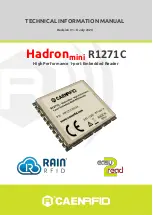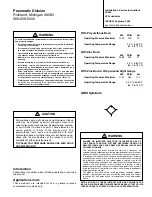
Rev 11.3/1-17
16
MRTALPR4-DC: #35057
T
O
A
PPLY THE
P
ADS TO A
L
OAD
Powering up the Lifter
Place the lifter's power switch in the “on” ( ) position.
8
The adjacent, blue power light
remains illuminated while the lifter is powered up. Keep the power switch in the “on” position
while lifting a load. Any power interruption during a lift could result in the release of a load and
possible injury to the operator or others (see T
O
L
IFT AND
M
OVE THE
L
OAD
: In Case of Power Failure
to follow).
WARNING: Never turn power off while lifting.
If the lifter is equipped with a Remote Control System, press the transmitter power button ( Ф )
and
hold it briefly
to activate the radio transmitter.
9
Note: If the transmitter is activated, the transmission indicator light flashes green when any
button on the transmitter is pressed and held; if the transmitter is not activated, the indicator
light flashes red (see B
EFORE
U
SING THE
L
IFTER
: Preparing to Use the Optional Remote Control
System preceding).
Positioning the Lifter on the Load
Make certain that the contact surfaces of the load and all vacuum pads are free of any
contaminates that could prevent the pads from sealing against the load (see MAINTENANCE:
V
ACUUM
P
AD
M
AINTENANCE
).
To lift loads in the
flat orientation (see INTENDED USE: T
YPICAL
A
PPLICATIONS
), center the pad
frame to within 2" [5 cm] of the load center (hereafter, "on center"), since off-center loading can
cause the load to hang at an angle or to tilt unexpectedly (see T
O
T
ILT THE
L
OAD
to follow), and it
may also damage the lifter.
10
To lift loads in the
upright orientation (see INTENDED USE: T
YPICAL
A
PPLICATIONS
), center the pad
frame from left to right on the load and determine which will be the top edge of the load while
lifting. Then position the vacuum pads near that edge (hereafter, "above center"). This
position will maximize stability while lifting the load.
If the lifter is positioned above center on a load encountered in the flat orientation, the load
automatically tilts to the upright position when lifted (see T
O
T
ILT THE
L
OAD
: Tilting Loads
Positioned Above Center to follow).
Note: The tilt latch will lock in the vertical position.
Make sure that all vacuum pads will fit entirely on the load’s contact surface (see
SPECIFICATIONS: Pad Spread) and that they will be loaded evenly while lifting (see
SPECIFICATIONS: Per-Pad Load Capacity). Then apply the lifter to the load so that all pads are
touching the contact surface.
8
When the operator powers up the lifter, either the stand-by function or the apply function is automatically activated,
depending on which was used last.
9
The radio transmitter turns off automatically, after a period of inactivity. The operator can also operate the lifter without
using the radio transmitter, if desired.
10
The lifter is designed to handle the maximum load weight (see SPECIFICATIONS: Maximum Load Capacity) when the load’s
center of gravity is positioned within 2" [5 cm] of the pad frame’s center point. Occasional loading deviations are permissible,
provided that the operator can maintain control of the load at all times and that the load weight is low enough to avoid damaging
the lifter.
















































